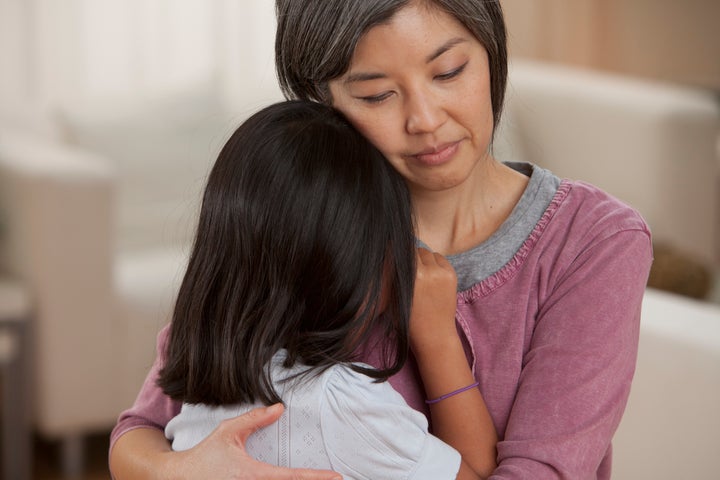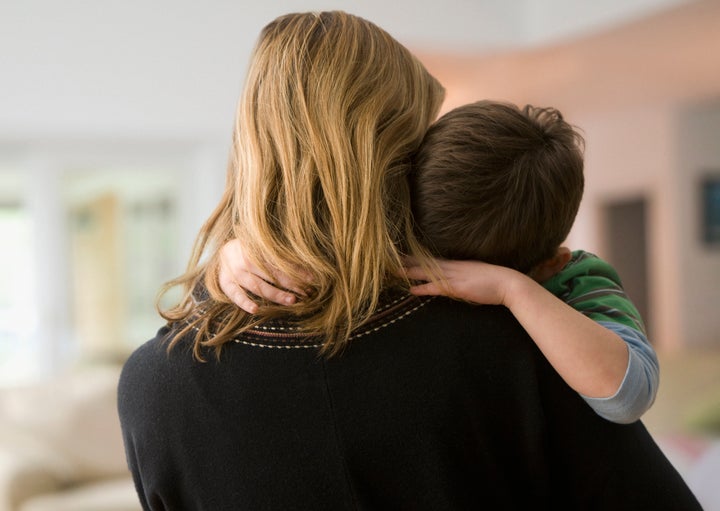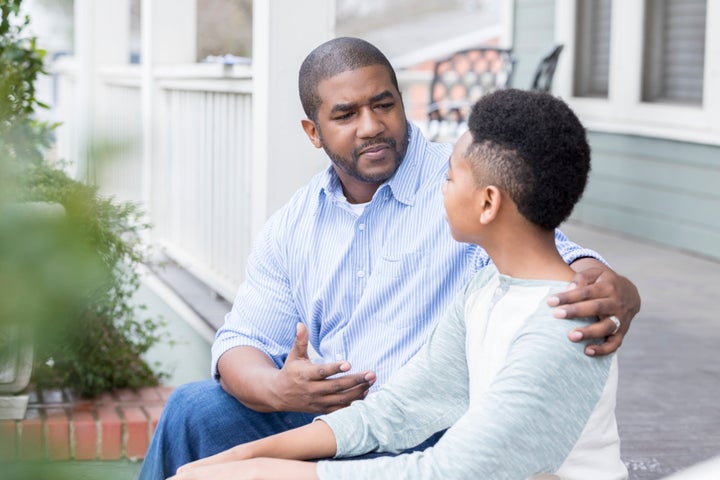
Anxiety doesn’t only affect adults. Many children struggle with feelings of anxiety, which can manifest in behavioral changes, regression, new sleeping and eating patterns, rumination, difficulty with transitions and more.
Child psychologists who have kids understand the important role parents can play in helping them deal with anxiety.
“Parents are the first teachers in their child’s life,” said Claire Nicogossian, clinical psychologist, clinical assistant professor of psychiatry and human behavior at Brown University and author of “Mama, You Are Enough: How to Create Calm, Joy and Confidence Within the Chaos of Motherhood.″
“Day-to-day routines and schedules as well as interactions and coping skills, how stress and conflict are handled, all happen in the home,” she added. “And little eyes are most always watching, observing and taking in adult behaviors and situations. Parents set the stage and create the foundation for how a child manages and copes with emotions and feelings.”
So how exactly do child psychologists handle their own children’s anxiety? HuffPost asked Nicogossian and others to share their approaches.
They listen
“When my children experience anxiety from a nightmare, entering a new setting, or any other situation, I start by listening first. Not just listening to their words, but to their nonverbals, body language, all of it. You can learn a lot when you truly listen. The trick is to listen to themes underlying the words. What are they saying? What are they truly concerned about?” ― Ann-Louise Lockhart, pediatric psychologist and parent coach
“As my children got older, I focus on just being very open to listening and not trying to jump immediately into a problem-solving mode. I make sure I’m listening to them, offering insights, but not telling them what to do, helping them develop the skills to address it on their own. The goal is to create self-reliant children so we’re there as guides, not supervisors or bosses.” ― Jillian Roberts, child psychologist and founder of FamilySparks
They put themselves in their children’s shoes
“I try to put myself in my teen’s shoes. It’s all too easy to react from my own perspective (‘Her young worries are so small compared to mine’ or ‘She’s such a drama queen’ or ‘I’m too stressed to deal with this now’), but taking her perspective gives me more empathy for her.” ― Abigail Gewirtz, child psychologist and author of “When the World Feels Like a Scary Place: Essential Conversations for Anxious Parents and Worried Kids”
They pay attention to their own anxiety
“Children learn about emotions in general ― and anxiety in particular ― by watching us parents deal with our own anxiety, by seeing how we react to their worries, and through discussions of fears. Our own (parental) anxiety can easily affect our children; they are astute observers of us. So when we need to help them deal with anxiety, we need first to regulate our emotions (taking a few deep breaths, for example, or grounding ourselves by feeling our feet in our shoes and our shoes on the floor) so we don’t end up reacting (emotion-driven) rather than intentionally responding. Once we have a handle on our own emotions, we can help our children identify and label their worries, validate them, and truly listen to their concerns.” ― Gewirtz
They acknowledge that anxiety is natural
“I have four daughters ― twins age 18, a 12-year-old and 10-year-old ― and I can share, in my almost two decades of parenting, the reality is that part of your child’s development from baby to toddler to child to tween and teen, will be filled with anxious moments and emotions. The key for you as a parent is to know when anxious moments are expected and understandable (e.g., at age 9 months and 18 months, with separation anxiety from mom/dad/caregiver, anxious about loud noises, to feeling anxious about a bad dream, to riding the bus or going to school for the first time, taking a test, trying out for a sport or play) that may come and go here and there and when anxiety begins to develop into a pattern that creates distress and impairs functioning at home, school or with peer relationships.” ― Nicogossian

They validate their feelings
“I try always to validate her worries. Sometimes she might just need me to listen, but often she really is seeking a solution. Rather than dispensing advice, I’ll try to elicit her thoughts about what might help, and then help her sift through options, weigh pros and cons, and come up with ideas I certainly wouldn’t have thought of.” ― Gewirtz
“Instead of saying something like, ‘You have nothing to be scared of,’ I say, ‘I’m sorry this is scary for you, let’s talk about why you feel this way.’ Listening helps give my kids space to express their feelings. I try to normalize but not over-emphasize the anxious feelings. Providing a lot of attention to the source of anxiety strengthens the anxiety feedback loop, thereby strengthening future anxiety. After my kids tell me about their anxiety, I reassure them by telling stories about times I and/or others they love have felt the same.” ― Cindy Graham, licensed clinical psychologist
They help them verbalize what’s happening
“I provide an empathic response utilizing feeling words and somatic cues (‘You were so worried when you heard that strange noise outside and your heart started beating really hard inside of your chest’). In the middle of this, I find it very important to make connections between events, feelings, thoughts, and behaviors. That way, my children understand that their thoughts or feelings don’t just come from nowhere; there is a valid reason for all of it.” ― Lockhart
“At times my kids (ages 8 and 6), don’t always know how to express their anxiety. Children often do not have the insight to express why they are feeling anxious, especially when the fight-flight-or-freeze response triggers a freeze or flight response. I ask them to tell me how strong the anxiety is either by giving a 0 to 5 rating or by drawing a picture of a thermometer and marking off the level.” ― Graham
They pay attention to behavioral changes
“Anxiety in children can be present behaviorally and physically with the following: problems sleeping, changes in appetite, irritability, racing thoughts or having a lot of worry thoughts and fears, difficulty concentrating, muscle aches, fatigue, clingy behavior or not wanting to leave home or be away from parents, worrying about one’s safety as well as others, needing to be perfect and not make mistakes or ‘do things wrong,’ as well as signs of biting nails, skin picking, hair pulling. If you notice a trend or observe a pattern in your child, that anxiety is more than a passing moment to be expected and is impairing their functioning at home, school and with social relationships, please reach out to your pediatrician and health care provider for evaluation and support. This is so important to be evaluated to receive support and treatment.” ― Nicogossian
They empower them to come up with solutions
“When my kids are stressed out about something, I ask them: ‘Is there more than one way to approach this problem? How else can you manage this? Is there a different solution?’ ... The parent has to believe that their child has the ability to manage their own anxiety. A parent cannot be trying to fix the problem for the child, because then the child will never learn how to manage their own discomfort. Don’t tell kids what to do or what to try because if you’re giving them the suggestions, then they’re not figuring out the solution by themselves. Nobody likes being told what to do. A parent’s job is to give kids the opportunity to practice the skills that will help them build resiliency ― this is how they can overcome challenges and have stamina despite feeling emotionally upset. You can ask: ‘What can you do to feel better? How can you help yourself feel better?’ You’re teaching them self-care. Your child will become more resilient as they gain opportunities to ‘figure it out’ for themselves.” ― Jenny Yip, clinical psychologist and author
They encourage them to change their perceptions
“I validate what they are experiencing and don’t dismiss it or tell them they are fine. I then get them to recognize it’s their anxiety and that they’re having a false alarm. I try to prompt my kids to reframe their anxious thoughts and change their perceptions, even if their body is saying there is an emergency. Over time my kids have gotten very skilled at doing this.” ― Natasha Daniels, child therapist and creator of AnxiousToddlers.com
They foster quality time together
“I see parenting as being about relationship and attunement to our children, so that everything you do with your children from getting them to cooperate to listening to you, flows from this secure attachment. I find that giving my daughter a few minutes of quality connection time at the start of each day, where I give her my full attention such as reading a few books or getting down on the floor and playing helps her to feel ‘plugged into’ me and helps the rest of the day go much more smoothly. I find she’s more likely to cooperate and listen to me when she feels she has had enough quality time with me.” ― Genevieve von Lob, psychologist and author of “Happy Parent, Happy Child”

They prioritize self-care
“My main priority as a parent is putting my well-being and self-care first and ensuring that I am feeling calm, balanced and grounded. When I am feeling under pressure, I have noticed how much my daughter picks up on this and is more likely to respond by being more clingy or playing up. Children are like tuning forks and they pick up on our inner emotional state, even when we are doing our best to keep our true feelings hidden. My self-care regimen consists of breathwork, walks in nature, dancing to upbeat music and learning new skills. Above all else, the most crucial thing I practice is self-kindness, and giving myself permission to have a break or the odd duvet day. Like every parent, I inevitably have my off days when I am in survival mode and muddling through the day. No one is 100% calm and patient all the time and I try to always remind myself that I’m human.” ― von Lob
They share coping strategies
“Cognitive Behavioral Tools such as emotional regulation activities are very helpful. For example, a visual thermometer that shows colors that can be paired with levels of emotions are a great tool to use when your child is feeling anxious. Have your child show you by pointing to the thermometer where they are (red represents them feeling very overwhelmed ... to blue feeling calm). This helps your child self-identity and become aware of their own feelings. The more aware your child is of their own emotions, the better we are able to help them identify the early signs and triggers of anxiety. Using strategies to help cope will reduce anxiety attacks.” ― Reena B. Patel, licensed educational psychologist, board-certified behavior analyst and author of “Winnie & Her Worries”
“I have taught them a wide range of coping skills and activities (such as drawing, listening to music, reading helpful books, listening to relaxation videos or songs, using stress fidgets) and have these readily available to them to make it easier for them to use independently.” ― Graham
They collaborate
“I move into a collaborative joint solution (‘What do you think is a good solution for this?’ or ‘What do you need from me in this moment?’ or ‘When I feel super nervous, I take slow belly breaths while closing my eyes and focus my eyes on calming thoughts.’). Empowering, solution-focused parent language that instills a sense of autonomy and control gives your child the message that although they don’t know how to handle this situation right now, they now have the tools to handle it a little better in the future. In-the-moment tools are important too (belly breathing, muscle relaxation, imagery, yoga, journaling, calm-down jar, self-soothing activities), but I find they work best when they understand why they work.” ― Lockhart
They check in
“I would probably check in with the child and with all the important adults in the child’s life, like the teacher, dance teacher, piano teacher, to see if they observe a difference. When my second daughter was in grade one, I noticed a change in her, and after some careful investigating, I realized she was having a bullying experience at school. Sometimes children don’t want to burden parents. They don’t want to put their own problems on their parents’ plate. So it does sometimes require some sleuthing on the part of the parent to understand what might be going on.” ― Roberts
They give themselves grace
“Being an anxiety and OCD child therapist brings another complicated layer to this journey of raising anxious kids. It brings with it feelings of guilt and inadequacy. When my kids are having a rough time, insecurities pop up that I have to deal with. Thoughts like, ‘You’re a professional, your kids shouldn’t be struggling’ or ‘Why can’t you fix this faster?’ can weigh heavy on me and have to be reframed in my own mind. ... I know every anxiety theme, every possible trajectory of an anxious thought, every possible worst-case scenario. That can be a curse at times when your child is just having a mild anxiety theme and your mind goes to that dark place of where it can lead. The silver lining of being a child therapist is that you have all the skills and tools at your disposal. It’s hard raising anxious kids, and that upper hand can really help in the long run.” ― Daniels
Answers have been lightly edited and condensed for clarity.